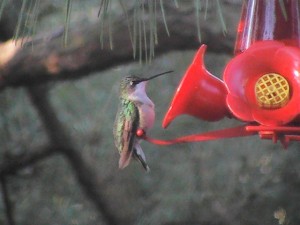No, I’m not talking about those of us who stay in the warm confines at Cataloochee, nursing Ninja porters, while the kids hit the slopes. These cold-weather wimps are ruby-throated hummingbirds. As most of you hummer-watchers know, our ruby-throats, basically the only nesting hummers in the eastern U.S., have generally all departed for warmer climes by the end of October. But are the times and maybe the climes changing?
My recent (Jan. 8-16) weekly installment of “This Week at Hilton Pond” titled “Winter Hummingbirds in the U.S. (Ruby-Throats & Global Warming)” raised some really interesting questions. This Week at Hilton Pond is a weekly e-newsletter produced by Hilton Pond Center for Piedmont Natural History’s executive director Bill Hilton Jr.
Hilton is no stranger to winter hummers. He has banded more than 80 winter hummers since 1991. I met Hilton back in 2002 when he came to the residence of Ted and Ann Kirby in Waynesville and banded a rufous hummingbird that had taken up residence – see http://www.smokymountainnews.com/issues/11_02/11_27_02/out_lola.html.
Hilton noted in the newsletter that despite all the vagrant hummers he had banded he had never banded a ruby-throated after Oct. 18 or before March 27. But according to Hilton’s account all of that changed this past December when he got a call from a friend from Buxton, Nc. This friend, who lives between the Atlantic Ocean and Pamlico Sound, reported that she had at least a half-dozen ruby-throated hummingbirds coming to feeders in her yard.
Hilton said they arrived in Buxton around 1:30 p.m. and that by 2:00 they had their first ruby-throat (a female) in the trap. In two days at Buxton, Hilton banded nine winter ruby-throats, seven (five females and two immature males) in his friend’s yard and two other females at an alternate site. Hilton noted that all the hummers were healthy and one was even going through its annual mid-winter molt.
Hilton, like any good scientist, is never more than a reflective moment away from “why” and/or “how.” And like any good scientist he would never posit one event as proof of anything, but keen anecdotal observations are the precursor of any hypothesis worth more study.
Hilton reflects that the warm Gulf Stream is only about 10 miles offshore of the Outer Banks and that it helps to moderate winter temps. But, “…even though the Gulf Stream has been this close for millennia there were NO reports of winter ruby-throats in North Carolina before about 1995 or so,” writes Hilton. He believes that ruby-throats on the Outer Banks may be benefiting from ever-so-slight increases in annual winter temperatures – gasp! “climate change.”
Hilton writes, “…Mountaintop glaciers melting . . . polar ice fields shrinking . . droughts worsening . . . severe storms increasing . . ocean levels rising (and even affecting dunes and beaches at Cape Hatteras National Seashore) . . . and now “cold weather wimp” Ruby-throated Hummingbirds wintering where they never have before…” and wonders out loud, “…if–because of their recently acquired ability to survive WITHOUT migrating to the Neotropics –Ruby-throated Hummingbirds are THE species that finally drives home the point that global warming is for real?”
To read Hilton’s entertaining narrative regarding the winter ruby-throats (along with his usual outstanding photography) and/or to learn more about Hilton Pond Center for Piedmont Natural History visit www.hiltonpond.org.

